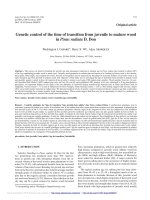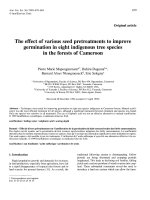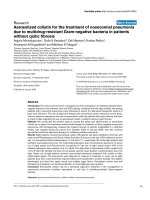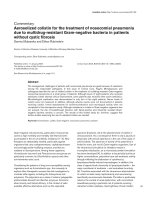The increase of radiation doses due to exploration activities in Yen Phu rare earth deposit, Yen Bai province, Northern Vietnam
Bạn đang xem bản rút gọn của tài liệu. Xem và tải ngay bản đầy đủ của tài liệu tại đây (439.17 KB, 8 trang )
Journal of Marine Science and Technology; Vol. 17, No. 4B; 2017: 130-137
DOI: 10.15625/1859-3097/17/4B/12735
/>
THE INCREASE OF RADIATION DOSES DUE TO EXPLORATION
ACTIVITIES IN YEN PHU RARE EARTH DEPOSIT, YEN BAI
PROVINCE, NORTHERN VIETNAM
Le Khanh Phon1, Phan Thien Huong2*, Jadwiga Pieczonka3, Adam Piestrzynski3, Nguyen
Dinh Chau3, Vu Van Bich4, Tran Thien Nhien4, Nguyen Thai Son4, Nguyen Thi Thu Duyen2
1
Vietnam Association of Geophysicists
Hanoi University of Mining and Geology
3
University of Science and Technology AGH, Krakow Poland
4
Division on Radioactive and Rare-earth Minerals
*
E-mail:
2
Received: 2-11-2017
ABSTRACT: Yen Phu rare earth deposit covering over 0.7 km2 in Yen Bai province, Northern
Vietnam contains heavy elements bearing radioactive materials. The area has been studied based on
data of several thousand meters of boreholes, 2000 m3 of trenches, shallow shafts, and thousands of
rock samples. This article shows the results of radioactive measurements and analysis by regular
grids before and after exploration activities. The investigated area has been divided into two
different subunits characterized by different levels of the radiation dose. It can be observed that after
the exploration process, equivalent dose increases by 1.2 mSv/y and reaches recent value of
9.9 mSv/y. This value is still below the acceptable value according to the ICRP regulations,
however, it should be noted that the increase can exceed the critical value during industrial
production and processing. Therefore it will be necessary to undertake investigation and
implementation of radioactive monitoring system to maintain the safety for people.
Keywords: HREE (heavy rare earth element) deposit, radiation dose, radon concentration.
INTRODUCTION
In the world, there are some scientific
researches on the increase in the radioactive
contents and radiation doses caused by the
activities of the exploration, exploitation and
processing for minerals containing radioactive
materials in general and rare earth minerals in
particular.
The researches on the radiation-ecological
problems of mineral-material exploitation at
deposits [1] has resulted in the determination
for radon concentrations and the annual
effective radiation doses in the open-pits and
mining enterprises.
130
The data in Table 1 shows that:
More than half the number of the nonuranium ore mines, the individual radiation
doses for Group B workers exceed the limit
dose (5 mSv/y).
24% of the ore mines have exceeded the
limit dose for the radiation staff (20 mSv/y), as
well as some mines reaching the doses of
90 mSv/y and 740 mSv/y in maximum.
At the rare earth ore mines, the average
values of radiation doses and thoron
equilibrium concentrations are higher than at
other ore mines. That confirms the strong
The increase of radiation doses due to…
relationship between rare earth ores and
radioactivity mainly thorium in nature.
The researches in the UK also show that the
average radiation dose (7 mSv/y) for the staff at
nuclear fuel processing enterprises is
significantly lower than that (26 mSv/y) in the
mines of poly-metal mines and other nonuranium mines (except coal mines) [2].
The previous researches in Vietnam have
mentioned only in the investigation, survey and
evaluation for natural radiation environment.
The Vietnam-Poland bilateral scientific
cooperation project, code number 01/2012/HDHTQTSP, was first assigned the task of
evaluating the environmental impact of
radioactivity caused by the activities of
exploration, mining and processing for
radioactive minerals in Vietnam.
This report gives an urgent problem to
study the increase of radiation dose caused by
the exploration activities at Yen Phu rare earth
mine (Yen Bai province) to ensure radioactive
safety on production and health protection for
mine staff and local people.
Table 1. General results of the researches on radiation status
in the open-pits and mining enterprises [1]
Equivalent equilibrium concentrations
Bq/m3
Ore mines
Copper ore
Coal
Gold and gold placer
Non-ore minerals
Rare earth ore
Polymetal ore
Iron ore
Uranium open-pits
Radon
Thoron
< 10-67 (19)
< 10-960 (42)
10-1000 (83)
< 10-2300 (270)
< 10-5800 (430)
< 10-48000 (570)
< 10-48000 (590)
≥ 10000
0.2-2.1 (0.7)
0.2-6.0 (1.9)
0.2-6.2 (1.9)
0.8-36 (8)
0.3-30 (3.1)
0.2-8.2 (2.6)
0.2-12 (2.8)
Radioactivity (X, µR/h)
Annual effective
radiation doses
(H, mSv/y)
6-10 (8)
4-22 (9)
8-32 (17)
6-50 (17)
6-140 (21)
4-45 (11)
5-300 (13)
≥ 1000
< 0.2-1.2 (0.4)
< 0.1-15 (0.7)
< 0.1-33 (1.6)
< 0.1-37 (6.3)
< 0.1-94 (7.4)
< 0.1-180 (9.3)
< 0.1-450 (10)
≥ 50
Notes: Values in parentheses ( ) are the means; H: Annual effective radiation doses based on calculation.
GEOLOGY-MINERAL CHARACTERISTICS AND EXPLORATION SITUATIONS
AT YEN PHU RARE EARTH MINE
Geology-mineral characteristics
Yen Phu rare earth ore deposit was
discovered by magnetic survey. Fergusonite,
xenotime, and monazite… are the main rare
earth minerals. Especially the heavy rare earth
elements (HREE) and niobium-rare earth group
minerals are dominant. Hydrothermal genesis is
considered as process for this mine [3].
There are two rare earth ore bodies (named
TQ.1 and TQ.2) in this mine. Quartz-rare earth
magnetite is the most dominant mineral. There
are rocks of quartz-sericite-carbonate schist and
sericite shale belonging to Song Mua
formation, as alternated or contacted with ore
bodies.
Two rare earth ore bodies are not large in
size, ventricular in form on both surface and
vertical cross section. On the surface, two ore
bodies occupy most of the mine area. Ore bodies
are mostly weathered, and the weathering degree
decreases with depth increases. From the top to
the bottom, there are two weathering zones as
follows:
Strongly weathering zone: compositions
of diluvia, fluvial materials covering the
surface of ore bodies with the thickness of 0.5 4.5 m, commonly from 1.5 m to 3.0 m. This
zone consists of strongly-weathering products
from rocks and ores. There are some parts
completely weathered as the brownish, reddish,
and porous soils with scattered boulders, debris
of magnetite, quartz, rocks.
Moderately
weathering
zone:
compositions of most of ore body mass. The
131
Le Khanh Phon, Phan Thien Huong,…
thickness of zone is quite large, from a few
meters to sixty meters. The weathering level in
depth is reflected in color from brownishyellow, reddish-brown to brown, dark-brown.
The rock structures are determined still rather
clearly as well.
Characteristics from two rare earth ore
bodies are described as follows:
TQ.1 (1st ore body): Located in the center
of the mine area, lens-shaped, it is about 260 m
long, 190 m wide and prolonging as the
Northwest - Southeast line. In vertical cross
section, TQ.1 looks like the lens with the
thickness from a few meters to sixty meters.
The ore body's thickness reduces in two ends.
This ore body consists mainly of quartz magnetite containing rare earth elements
(REE), alternated with different layers of rock
such as feldspar-sericite schist, quartz- sericite
schist, siliceous shale, lime shale ... with
thickness from tens of centimeters to tens of
meters. They are moderately weathered. Most
of the schist layers are alternating of the quartz
- magnetite containing REE in the form as
disseminations or stock works. Thus, these
schist layers become a part of the ore body.
Somewhere the TR2O3 contents are over 1%.
At current terrain, TQ.1 is distributed at the
altitudes of 30 m to 135 m.
According to the results from 1942
chemical samples, TR2O3 concentration ranges
from 0.01% to 8.62% TR2O3, average of
1.18%; variation of contents (Vc) = 73.49%.
The ICP-analysis results of 176 samples
have showed the average contents of REE as
follows: La = 9.55%; Ce = 23.67%; Pr =
4.31%; Nd = 19.87%; Sm = 14.51%; Eu =
0.51%; Gd = 9.40%; Tb = 0.58%; Dy = 3.08%;
Ho = 0.39%; Er = 3.16%; Tm = 0.09%; Yb =
0.97%; Lu = 0.04%; Y = 9.88%. The HREE
oxides consist of 31.29% compared to total rare
earth oxides (TR2O3).
TQ.2 (2nd ore body): Located in the
southwest of the mine area, ventricular form,
about 140 m long, over 70 m wide, extending
in the direction from northwest to southeast. In
the vertical cross section, the ore body looks
like a basin in shape, the thickness of 30 meters
at most. TQ.2 consists mainly of quartz magnetite containing REE. In addition, the ore
bodies are alternated with several layers of
different rocks such as shale, siliceous shale,
sericite shale, thin layer quartz-sericite-calcite
schist, quartz-sericite schist. They are
weathered, with weathering thickness from tens
of centimeters to tens of meters. Most of the
schist layers contacted to quartz - magnetite
containing rare earths in the form as
disseminations or stock works. Thus, these
schist layers become a part of the ore body,
similar to TQ.1. In some places, the TR2O3
concentration is over 1%. TQ.2 is distributed at
the altitudes of 60m to 160 m.
Results from 408 chemical samples show
that concentration of TR2O3 ranges from 0.01%
to 3.70% , average of 0.76%; Vc = 82.63%.
The ICP-analysis results from 24 samples
show that the average contents of REE: La =
7.21 %; Ce = 25.72 %; Pr = 2.96 %; Nd =
15.26%; Sm = 13.57%; Eu = 0.40 %; Gd =
10.65%; Tb = 6.62 %; Dy = 2.20%; Ho = 0.39
%; Er = 1.49 %; Tm = 0.05%; Yb =0.95%; Lu
= 0.04 %; Y = 8.50 %. The HREE oxides
occupy 29.11% compared to total rare earth
oxides.
Iron: Analysis results of 24 samples
show the total iron contents (TFe) from 11.66%
to 43.00%, average 29.91%, Vc = 28.52%.
Niobium: Nb2O5 from 0.01% to 0.04%,
average 0.02%, Vc = 37.95%.
Exploration history in Yen Phu mine
Iron: Analysis results of 98 samples
show the total iron contents (TFe) from 2.55%
to 56.53%, average 33.28%; Vc = 39.10%.
From 1986 to 1991, Geological Division
150 (the member of Division on Radioactive
and Rare-earth Minerals) has carried out the
project “Searching for radioactive - rare earth
ores at Yen Phu area” by the author Pham Vu
Duong [3].
Niobium: Nb2O5 from 0.01% to 0.23%,
average 0.03%; Vc = 111.78%.
The exploration activities
implemented as follows:
132
have
been
The increase of radiation doses due to…
Geo-mineral and hydro-geological mapping
at scale of 1:1000 on the area of 0.753 km2.
Geological drilling 983 m long.
Hydro-geological
(1 borehole).
drilling
90
radon concentrations in air, which are measured
before (fig. 1) and after (fig. 2) exploration
activities:
m
Digging wells (to 20 m deep, 2 wells).
Digging trenches (to 8 meters deep), a
total of 2,001 m3 in volumes.
Analyzing several samples of various
kinds.
Gamma-ray measurements at trenches and
wells: 17,352 points.
Gamma-ray measurements on drilling
cores: 7,882 points.
Spectrometric
1,028.5 m.
gamma-ray
logging:
Fig. 1. Contour map of gamma radiation dose
rates before exploration activities
METHOD TO STUDY THE INCREASE
ON RADIATION DOSE CAUSED BY
EXPLORATION ACTIVITIES
The increase on radiation dose caused by
exploration activities is determined according
to the radioactive environment survey data,
carried out at two times: before and after
exploration activities.
Before exploration activities, 284 points of
gamma radiation dose rates (GDR) and 135
points of radon concentrations in air were
measured to determine the local natural
radiation background.
After exploration activities, 299 points of
gamma radiation dose rates and 156 points of
radon concentrations in air were measured to
determine the increase in radiation dose caused
by exploration activities.
Making geological sections and contour
maps
on
radioactive
environment
parameters, before and after exploration
To overview wholly the increase of
radiation dose, we generate the contour maps of
gamma radiation dose rates before and after
exploration activities, and vertical section of
profile No. 89 displaying the ore bodies and
graphs of the gamma radiation dose rates,
Fig. 2. Contour map of gamma radiation dose
rates after exploration activities
Before exploration activities: The GDR
values vary from 0.3 to 0.6 μSv/h and more,
average of 0.53 μSv/h. In the most area of the
mine GDR values rise up more than 0.6 μSv/h.
After exploration activities: The GDR
values vary from 0.05 to 2.6 μSv/h, average of
0.84 μSv/h. In the most area of the mine GDR
133
Le Khanh Phon, Phan Thien Huong,…
values range from 0.4 to 1.3 μSv/h. In the area
of two ore bodies, GDR rates range from 0.9 to
2.6 μSv/h.
In the area of two ore bodies, it can be seen
that the GDR values have increased much more
than before exploration activities. The
expansion of the gamma anomalies at the Yen
Phu mine is resulted from the exploration
activities.
Comparing the radon concentrations, GDR
measured before with after exploration
activities (fig. 3), we can see that:
compared with after-exploration one of
0.60 μSv/h. The highest increase in GDR is
found (increasing value of 0.4 μSv/h) at the
location of new borehole.
Determining the additional radiation doses
by the means calculated before and after
exploration
To determine the additional radiation doses
(ARD) for radioactive influences, it is
necessary to get the means of GDR values in
the mine. The data is collected before and after
exploration activities. These means are
calculated from the network points regularly
distributed over the area. In fact, the radioactive
survey points have been distributed irregularly
in the survey area. So we have used the method
of dividing the survey area of Yen Phu mine
into equal grid. For every cell, the means of
GDR and radon concentration are calculated.
Then the external and internal radiation doses
are calculated consequently at the whole survey
area.
Based on the contour map of GDR values,
measured before exploration activities, we have
divided the survey area of Yen Phu mine into
88 cells and calculated the mentioned
parameters (fig. 1):
Radon concentration in air measured before exploration (Bq/m3);
Radon concentration in air measured after exploration (Bq/m3);
Gamma radiation dose rate measured before exploration (Sv/h);
Gamma radiation dose rate measured after exploration (Sv/h).
ertical geo-radioactive section No.89
Fig. 3. Vertical geo-radioactive section No. 89
Before exploration activities: Radon
concentrations in air vary from around
36 Bq/m3 to 82 Bq/m3, average value is 44
Bq/m3 (Hpbefore = 44 * 0.047 = 2.1 mSv/year).
After exploration activities: Because of ore
excavations, radon gas is dispersed, so radon
concentrations in air increase, the values range
from 39 Bq/m3 to 68 Bq/m3, average value is
53 Bq/m3 (Hpafter = 53 * 0.047 = 2.5 mSv/year).
The GDR values measured at 1m elevation
on the same site, before and after exploration,
change insignificantly. The average value of
before-exploration GDR is 0.54 μSv/h
134
The number of cells having the means of
GDR of above 0.65 μSv/h occupies 52.2% of
the whole survey area, distributed in two ore
bodies. The first ore body (TQ.1) consists of
47% of the whole survey area, located in the
center of the survey area. The second ore body
(TQ.2) consists of 5.2% of the whole survey
area, located in the southwest of the survey
area. Both ore bodies extend in the westsoutheast direction.
The number of cells having the means of
GDR from 0.5 to 0.65 μSv/h occupies 15.4% of
the whole survey area, surrounding two ore
bodies.
Correspondingly, the number of cells of
GDR from 0.4 to 0.5 μSv/h - 18.8%; from 0.3
to 0.4 μSv/h - 8.8% ; under 0.3 μSv/h - 11.8%
of the study area.
So we can calculate the mean of GDR at
the whole survey mine area, before exploration
activities:
The increase of radiation doses due to…
HSLbefore = 0.53 µSv/h
HNafter = 0.84 µSv/h * 8760h = 7.4 mSv/year
Then the mean of the external radiation
dose at the whole survey mine area, before
exploration activities [4]:
HNbefore= 0.53 µSv/h * 8760h = 4.6 mSv/year
Similarly, based on the contour map on
GDR, measured after exploration activities, we
have divided the Yen Phu survey mine area
into 62 cells and calculated the mentioned
parameters (fig. 2):
The number of cells having the means of
GDR of 2.25 μSv/h occupies 5% of the whole
survey area, in the southeast.
Correspondingly, the number of cells of
GDR of 1.3 μSv/h - 35.6%; 0.65 μSv/h - 40.4%;
0.32 μSv/h - 8.1%; and 0.13 μSv/h - 9,7% of the
survey area.
So the mean of GDR at the whole survey
mine area, after exploration activities:
HSLsfter = 0.84 µSv/h
And the mean of the external radiation
dose at the whole survey mine area, after
exploration activities [4]:
Similarly we calculate the means of the
internal radiation doses at the whole survey
mine area caused by radon in air (by
inhalation), before and after exploration
activities:
Hpbefore = 2.1 mSv/year
Hpafter = 2.5 mSv/year
Based on these results, we can calculate the
radiation doses, before and after exploration
activities, then the additional radiation dose
caused by the exploration activities at the Yen
Phu rare earth mine.
Total equivalent radiation dose is calculated
as the formula [5]:
H∑(mSv/year) = Hn + Hp +Hd
Where: H∑: Total equivalent radiation dose; Hn:
External radiation dose; Hp: Internal radiation
dose by inhalation; Hd: Internal radiation dose
by ingestion.
Table 2. Results of determination for the additional radiation dose caused
by the exploration activities at the Yen Phu mine
Radiation doses, calculated before
exploration activities (local radiation
dose background) (mSv/year)
Radiation doses, calculated after
exploration activities (current
radiation dose) (mSv/year)
Mine
Hn
Hp
H∑
Hn
Hp
H∑
Additional radiation
dose caused by the
exploration activities
(mSv/year)
Yen Phu
4.6
2.1
8.7
7.4
2.5
9.9
1.2
Doses
Notes: Since there is no data for the analysis of radioactive substances in food and water
samples, it results in a lack of data on internal radiation dose by ingestion; Hn: External radiation
dose; Hp: Internal radiation dose by inhalation; H∑: Total equivalent radiation dose.
Assessing the impact of radioactive
environment caused by the exploration
activities at Yen Phu mine
(1999) for natural radiation doses: The current
radiation dose of 10 mSv/y is the critical value
taking the interventions [5].
The assessment of the impact resulted from
additional radiation doses for the environment
and human health caused by exploration
activities based on the following legal
documents:
Yen Phu rare earth mine has conducted
the exploration activities causing the increase
of the radiation doses, considered as “the
radiation works”. Therefore, it is necessary to
be based on International Radiation Safety
Standards (IAEA, 1996) and Vietnamese
Standards (Circular 19/2012 of the Ministry of
Science and Technology) [6, 7].
Recommendations
of
International
Commission on Radiation Safety (ICRP)
135
Le Khanh Phon, Phan Thien Huong,…
Due to the exploration activities, the total
annual radiation dose (H∑) at Yen Phu mine is
9.9 mSv/y (table 1). Taking account of the
contribution of the internal radiation dose by
ingestion (Hd), the total current annual dose of
Yen Phu mine will certainly exceed 10 mSv/y,
consequently, it is necessary to have the
interventions. It should be noted that the
interventions here are understood as carrying
out some procedures to reduce the radiation
doses down to below 10 mSv/year. For
reducing the external radiation doses, some
solutions can be used: thick brick walls for
houses, not building houses on the high level
radiation places... For reducing the internal
radiation
doses
(reducing
the
radon
concentrations in air), it is necessary to live in
the houses on stilts; the houses facing the
southeastern direction for being airy; using fans
as well...
Exploration activities at Yen Phu mine
have resulted in the ARD of 1.2 mSv/y,
exceeding the limit value of 1 mSv/y.
According to the radiation safety standards of
IAEA and Vietnam, the ADR is 1 mSv/y higher
than the limit level for civilians, but it is too
low for the radiation staff (the limit level of
ARD for radiation staff is 20 mSv/year).
Fortunately, there are no inhabitants at this
mine area, so the impact of the current
radioactive environment at the Yen Phu mine
remains under the allowable limits of the
radiation doses.
CONCLUSIONS
Based on dividing the area of the Yen Phu
rare earth mine into equal cells, we have
determined the values of radiation dose,
calculated after exploration activities (current
radiation dose) of 9.9 mSv/y, and the ARD of
1.2 mSv/y. Taking account of the contribution
of the internal radiation dose by ingestion (Hd),
the total current annual dose of Yen Phu mine
will certainly exceed 10 mSv/y.
According to the recommendations of the
International Commission on Radiation Safety
(1999), the current radiation dose of 10 mSv/y
is the level at which it is necessary to carry out
136
the interventions for reducing the radiation
dose down to below 10 mSv/year.
According to the radiation safety standards
of IAEA (1996) and Vietnam (Circular
19/2012/TT-BKHCN), at Yen Phu mine, the
ARD of 1.2 mSv/year is exceeding the safety
standard for civilians (1 mSv/year) but still too
low for the radiation staff (20 mSv/year).
Fortunately there are no inhabitants in this mine
area, so the impact of the current radioactive
environment at the Yen Phu mine remains under
the allowable limits of the radiation doses.
In the coming time, the Yen Phu rare earth
mine will be put into the exploitation and
processing, which will surely increase the
radioactivity and radiation doses at this mine
and the adjacent area. So it is necessary to
survey the radioactive environment for
determining ARD caused by mining and
processing activities to ensure the radioactive
safety for staff and human health.
The report is completed by collecting and
processing data from Division on Radioactive
and Rare-earth Minerals and research results of
the Vietnam-Poland bilateral cooperation
project No. 01/HD-HTQTSP.
REFERENCES
1. Kotova, V. M., Pelumxki, G. A., 2002. The
researches on the radiation-ecological
problems of mineral-material exploitation
at deposits. Scientific Publication on The
Earth, PAEH, 2002, 9th issue, pages of 1526 (in Russian).
2. Roxman, G. I., Bakur, A. E., Petrova, N. V.,
2012. The radiation ecology for industrial
mineral materials. Moscow, 318 p (in
Russian).
3. Pham Vu Duong, 1992. Result report of the
radioactive - rare earth ore investigation at
Yen Phu area. Division on Radioactive and
Rare-earth Minerals.
4. Le Khanh Phon, Phan Thien Huong, 2016.
Environmental Radiation. Construction
Publishing House. Hanoi.
5. ICRP 1999. International Commission on
Radiological Protection, Protection of the
The increase of radiation doses due to…
Public in Situations of Prolonged Radiation
Expose. Publication 82.
6. Circular No 19/2012/TT-BKH dated
08/11/2012 of the Ministry of Science and
Technology. Provisions on control and
safety of radiation in occupational radiation
doses and public radiation doses. 2012,
Hanoi.
7. IAEA, 1996. International Basic Safety
Standards for Protection against Ionizing
Radiation and for the safety of Radiation
Sources. Vienna.
137









